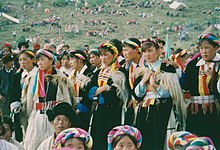|
Shangri-La, Yunnan
Shangri-La (Chinese: 香格里拉; pinyin: Xiānggélǐlā; Tibetan: སེམས་ཀྱི་ཉི་ཟླ།) is a county-level city in northwestern Yunnan province, China, named after the mythical land depicted in the 1933 novel Lost Horizon. It is the capital and largest city of Diqing Tibetan Autonomous Prefecture. It is bordered by the city of Lijiang to the south and Sichuan province to the northwest, north, and east. NameThe city was originally a county named Zhongdian (中甸县; Zhōngdiàn Xiàn); the Tibetan population referred to the area by its traditional name Gyalthang (Tibetan: རྒྱལ་ཐང་, Wylie: rgyal thang, ZYPY: Gyaitang), meaning "royal plains". On 17 December 2001, the Chinese government renamed the county "Shangri-La", after the fictional land of Shangri-La in the 1933 James Hilton novel Lost Horizon. This renaming, along with the county's upgrade to a county-level city on 16 December 2014, was part of an effort by the Chinese government to promote tourism in the area. The Chinese name of the county seat, Jiantang (建塘; Jiàntáng), reflects a Mandarin transliteration of Gyalthang. HistoryIn the early morning of 11 January 2014, a fire broke out in the 1,000-year-old Dukezong Tibetan neighborhood. About 242 homes and shops were destroyed and 2,600 residents were displaced.[3] About half of the old town was destroyed by the fire. Afterwards, residents were allowed back to their homes and shops. By the end of 2014 rebuilding had started and tourism started to return. Tourism was generally not affected by the fire, since the main sights in the old town, such as the prayer wheel and temples, were not damaged. Many of the other main sights are located outside of the old town. Demographics and languages The southern half of the city is inhabited by the Naxi people, who speak the Naxi language, a Lolo-Burmese language separate from the Tibetic languages. The northern half is inhabited by the Khampas, who speak the southern variety of Khams Tibetan. Southwestern Mandarin is spoken by the Han Chinese throughout the city. The ambiance of the town is distinctly Tibetan with prayer flags fluttering, mountains known by holy names, lamaseries and rocks inscribed in Tibetan language with Buddhist sutras.[4][5][6] Administrative divisionsShangri-La city has 4 towns, 6 townships and 1 ethnic township.[7]
ClimateShangri-La has either a dry-winter, warm-summer humid continental climate (Köppen climate classification: Dwb) using the 0 °C (32 °F) isotherm, or a dry-winter subtropical highland climate (Köppen climate classification: Cwb) using the −3 °C (26.6 °F) isotherm, both of which are unusually cool by Yunnan standards due to the high elevation, which ranges between 2,700 and 3,500 metres (8,900 and 11,500 ft). Winters are chilly but sunny, with a 24 hour January average temperature of -2.0 °C (28.4 °F), while summers are cool, with a 24 July-hour average temperature of 13.9 °C (57.0 °F), and feature frequent rain; more than 70% of the annual precipitation is delivered from June to September. The annual mean is 6.32 °C (43.4 °F). Except during the summer, nights are usually sharply cooler than the days. Despite the dryness of the winter, the small amount of precipitation is generally sufficient to cause major transportation dislocations and isolate the area between November and March.
National park 
Transport
See also
References
Further reading
External linksWikivoyage has a travel guide for Shangrila. Wikimedia Commons has media related to Shangri-La, Yunnan. |
|||||||||||||||||||||||||||||||||||||||||||||||||||||||||||||||||||||||||||||||||||||||||||||||||||||||||||||||||||||||||||||||||||||||||||||||||||||||||||||||||||||||||||||||||||||||||||||||||||||||||||||||||||||||||||||||||||||||||||||||||||||||||||||||||||||||||||||||||||||||||||||||||||||||||||||||||||||||||||||||||||||||||||||||||||||||||||||||||||||||||||||||||||||||||||||||||||||||




